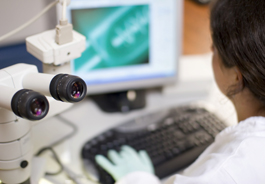Veterinary Forensics: A Voice for Animal VictimsAugust 19, 2014  iStockphoto It wasn’t your typical murder spree. For two months in 2001, two Florida teens went on a two-month killing spree—killing and maiming animals throughout Hillsborough and Pinellas counties. Two bulls were shot with razor arrows, a goat was tortured to death, a mother llama was sodomized and her baby beaten with a broken golf club, and a third llama was slashed with a meat cleaver. It was the blood of one of those llamas that helped put the young men behind bars. At the Forensics Unit of UC Davis’ Veterinary Genetics Laboratory, we see many cases of animal cruelty, dog fighting, and bestiality. Sadly, we can’t help the victims of abuse, but we can help to make a future where their assailants are held accountable and future potential victims are spared. Forensics speaks volumesAnimals may not speak the same language as humans, but they have a lot they can tell us when they share our lives. At the VGL Forensics Unit, we become their voice when they have something to say—about their abuse, about what they witnessed, or where they have been. Locard’s exchange principle maintains that every contact leaves a trace, and that exchange can bear mute witness to each and every crime. Pet ownership in the U.S. has more than tripled since the 1970s, with over 60 percent of American households now having at least one pet. It is almost impossible to enter a home where a cat or dog lives and not walk away with some of their fur. If you own a cat or dog, you know that their fur accompanies you throughout the day; from your home to your car; from your car to your office. That fur (or saliva, urine, blood, or feces) can become crucial evidence in forensic investigations. Twenty years ago, DNA profiling using short tandem repeats, or STRs—short inherited sequences of DNA that vary in length and can be used as molecular markers and for genetic fingerprinting--was just starting to be widely used for analyzing human biological evidence. Animal DNA testing using the same techniques was largely reserved for confirming parentage and testing for genetic traits or diseases. Today, animal forensics has become an important tool as investigators reach out in hard-to-solve cases to develop new leads or to confirm lines of investigation. While still not as widely recognized as human DNA profiling, animal DNA profiling has been used in every state of the U.S. to link both human and animal victims to offenders. Veterinary forensics helps humans, tooIt all began in 1999 when the UC Davis Veterinary Genetics Laboratory received an unusual request. We were contacted by a sheriff’s office from rural Iowa to see if we could match urine swabbed from a suspect’s truck tire to a victim’s dog. A young woman working in her garden was assaulted by a man who had driven up, asking for directions. When she approached his truck, he tried to sexually assault her and drag her into the vehicle, but she managed to get away. Although she wasn’t able to identify the suspect in a police line-up, she did remember her black and white Border Collie-mix lifting his leg on one of the truck tires. We were excited to find a DNA match and, with that information, the suspect pled guilty and served two years for attempted assault. This was the first time it became clear to us there was a need for a forensic laboratory dedicated to animal DNA profiling. Since that time, we have applied those techniques—and developed new ones—to bring the emerging field of veterinary forensic science to the same standards as human crime laboratories. In 2010, the Forensic Unit of the Veterinary Genetics Laboratory became the first crime laboratory in the world to be accredited for forensic DNA profiling of domestic animals. The majority of our cases are from the U.S. and Canada, with occasional cases arriving from Great Britain, South America, Australia and Japan as investigators seek out expertise in this specialized area. As part of one of the largest animal DNA testing laboratories in the world, we have databases available for dogs, cats, horses, cattle, sheep, goats, pigs, deer, elk, wolves, coyotes, bear, llamas, and alpacas--providing for a diverse range of potential cases. Solving a wide range of crimesAnimal evidence can help solve a wide range of cases from animal cruelty or theft, to animal attacks on humans or other animals, and human-on-human crimes like robbery, rape, and murder where there is a transfer of evidence. Dog feces evidence collected from clothing in two different violent crimes was analyzed and presented in court to help convict defendants in a triple homicide and in a rape. Besides being the “witness” at a crime scene, animals themselves are frequently the victims of crimes. Blood evidence found on the clothing of burglary suspects who silenced barking dogs by slitting their throats or by placing them in a lit oven has been used to prosecute offenders. Domestic violence often involves animal abuseOften animals are tortured or killed by someone trying to control another person in domestic violence situations. Up to 80 percent of women arriving at domestic violence centers report animal abuse by their partners. In the case of Jeffrey Nally Jr., his girlfriend’s mother reported that her daughter was being held against her will and that Nally had threatened to kill her if she tried to leave. A search of his home revealed 29 dog carcasses and three live puppies. On the day he was arrested, Nally had terrorized his girlfriend by forcing her to hold a puppy while he drilled into its head. Hair recovered from the drill was matched to the dead puppy and blood found on a hammer was matched to another body found on the property. Nally pled guilty to a lesser charge of nine counts of animal cruelty and weapons possession. With every state now providing a felony crime for animal cruelty, it has been well documented that animal cruelty is a significant indicator for violent criminal behavior against humans as well. DNA profilingUnlike what you may see on television, not every sample yields a DNA profile. Pet hair is the most commonly collected item of non-human biological evidence and is not suited to individual (nuclear) DNA profiling. However—unlike humans—dog and cat hairs without roots can yield enough DNA for individual DNA profiling. That’s because when they groom themselves, they are leaving saliva on the hair shafts—and that saliva contains cells. About 1 in 15 shed dog hairs will have enough nuclear DNA for individual profiling. The more fastidious cats average about 1 in 4 hairs with sufficient nuclear DNA. The likelihood of getting that DNA profile goes down when those hairs have been laundered, buried, immersed, or have had prolonged exposure to the outdoor environment. Even in those cases, the mitochondrial DNA found in the cytoplasm of all animal cells can be tested to include or exclude a contributor. Mitochondrial DNA has many more copies in each cell and is more stable due to its circular shape. Because it persists longer than nuclear DNA, it is especially useful when samples are degraded. It is inherited through the maternal line, so everyone—people and animals—has the same mitochondrial DNA as their mother. Even though it is not unique to an individual, it can identify or exclude possible contributors and assist in the progress of an investigation. It is also commonly used to identify the species of an unknown sample. Proper collection of evidence is essentialAs veterinary professionals, you are often the first people that enforcement officers turn to when they encounter a case involving an animal. It’s important to correctly collect and document potential DNA evidence. Some tips to keep in mind if you handle a case with potential DNA evidence are:
As the only lab in the country doing this type of work, we feel very fortunate to be at the forefront of an interesting, diverse, and evolving field. It’s especially rewarding when we hear from pet owners who have found peace thanks to our work. While we can’t relieve the suffering of innocent animals, we can take comfort that we’re making the world a better place by helping to get abusers off the streets and preventing more animals from being victimized.  Beth Wictum Beth Wictum first began her career in animal profiling in 1979 after obtaining her B.S. in Zoology. In the early 90s she helped lead the transition from blood typing to DNA typing in domestic animals, where she developed identity panels and disease diagnostic tests for horse, dog, cattle, and elk. As the demand grew for forensic testing, she was tapped to lead that unit, switching entirely to forensics in 2000. She is a member of the American Academy of Forensics Sciences, the California Association of Crime Lab Directors, the International Society for Animal Genetics forensic standing committee, the Society for Wildlife Forensic Sciences proficiency testing board, and has acted as an advisor to the Scientific Working Group for Wildlife and the Judicial Council of California Science and the Law steering committee. She can be reached at [email protected]. For more information about VGL Forensics, visit http://www.vgl.ucdavis.edu/forensics. |
